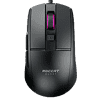 9
9
ROCCAT Burst Core Review
Value & Conclusion »Software
The Burst Core is compatible with ROCCAT Swarm, which is used for other ROCCAT devices as well. Though a bit crowded and dated in its design, Swarm leaves little to be desired in terms of functionality. All options are accessible through separate pages. The first of these includes the basic Windows pointer settings and CPI adjustment, which ranges from 200 to 8500 CPI in increments of 100 and for up to five levels. Values can be entered manually, but non-native inputs are truncated to native values, as they should be. Additionally, values for x and y-axis can be set separately. All buttons can be remapped to mouse, keyboard, or media functions, and EasyShift allows one to designate a shift button that can be pressed to access a second set of bindings. Further options include polling rate adjustment (125/250/500/1000 Hz). By default, LED sleep timer is enabled, which turns the lighting off after a set period of inactivity. In order to disable this option, "None" ought to be selected. Lastly, a macro editor and profile management are included as well. When applied, all settings are saved to the on-board memory, so the software does not need to be running (or be installed) all the time. On my system, the software had a RAM footprint of 65 MB on average when running in the foreground, which doesn't change when minimized to the task bar, but goes down to 26 MB upon closing the application (minimized to the system tray). Upon exiting the application, all processes are terminated, as they should be.
Lighting
The Burst Core has but a single zone for RGB lighting, which is the scroll wheel. A total of six pre-defined lighting effects are available in the software. These are AIMO, Wave, Fully Lit, Heartbeat, Breathing, and Blinking. For most effects, it is possible to set custom colors and adjust brightness and transition speed. Though there is no dedicated option for this, the lighting can be disabled by setting the brightness to its minimum.Color accuracy and vibrancy are excellent throughout. Here's a short demonstration video in which I'm going through the AIMO, Wave, and Breathing modes:
Jul 5th, 2025 18:02 CDT
change timezone
Latest GPU Drivers
New Forum Posts
- How do you view TPU & the internet in general? (With poll) (80)
- EVGA XC GTX 1660 Ti 8GB ROM (11)
- What are you playing? (23893)
- Do you use Linux? (677)
- Optane performance on AMD vs Intel (58)
- Frametime spikes and stuttering after switching to AMD CPU? (521)
- Stalker 2 is looking great. (187)
- b550m aorus elite not posting with new ram (7)
- Gigabyte graphic cards - TIM gel SLIPPAGE problem (131)
- Can you guess Which game it is? (203)
Popular Reviews
- NVIDIA GeForce RTX 5050 8 GB Review
- Fractal Design Scape Review - Debut Done Right
- Crucial T710 2 TB Review - Record-Breaking Gen 5
- ASUS ROG Crosshair X870E Extreme Review
- PowerColor ALPHYN AM10 Review
- Sapphire Radeon RX 9060 XT Pulse OC 16 GB Review - An Excellent Choice
- Upcoming Hardware Launches 2025 (Updated May 2025)
- AMD Ryzen 7 9800X3D Review - The Best Gaming Processor
- Sapphire Radeon RX 9070 XT Nitro+ Review - Beating NVIDIA
- NVIDIA GeForce RTX 5060 8 GB Review
TPU on YouTube
Controversial News Posts
- Intel's Core Ultra 7 265K and 265KF CPUs Dip Below $250 (288)
- NVIDIA Grabs Market Share, AMD Loses Ground, and Intel Disappears in Latest dGPU Update (212)
- Some Intel Nova Lake CPUs Rumored to Challenge AMD's 3D V-Cache in Desktop Gaming (140)
- NVIDIA GeForce RTX 5080 SUPER Could Feature 24 GB Memory, Increased Power Limits (115)
- Microsoft Partners with AMD for Next-gen Xbox Hardware (105)
- NVIDIA Launches GeForce RTX 5050 for Desktops and Laptops, Starts at $249 (105)
- AMD Radeon RX 9070 XT Gains 9% Performance at 1440p with Latest Driver, Beats RTX 5070 Ti (102)
- Intel "Nova Lake‑S" Series: Seven SKUs, Up to 52 Cores and 150 W TDP (100)



